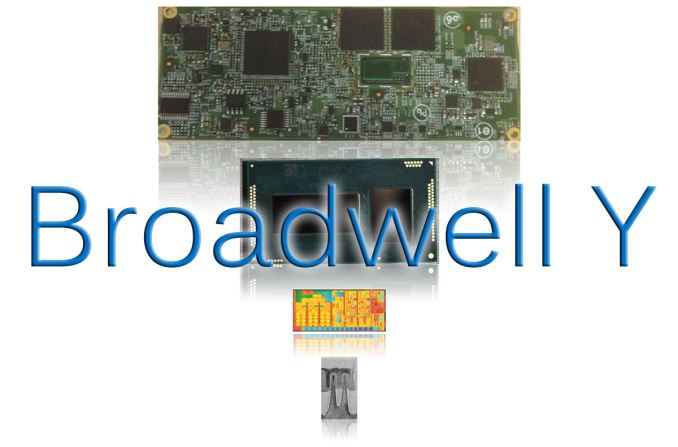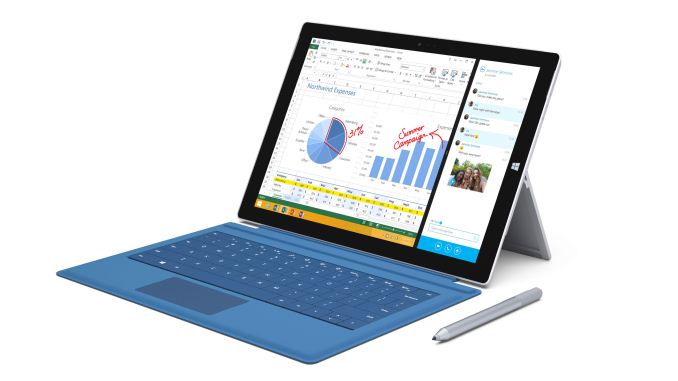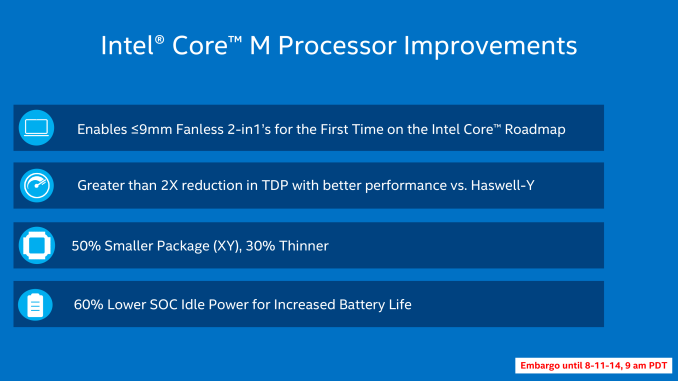Short Bytes: Intel's Core M and Broadwell-Y SoC
by Jarred Walton on August 12, 2014 6:00 AM EST- Posted in
- Short Bytes
- CPUs
- Intel
- Mobile
- Laptops
- Tablets
- Broadwell
- Core M
- Broadwell-Y

Intel has slowly been feeding us information about their upcoming Broadwell processors for a couple years now, with the first real details kicking off almost a year ago at IDF 2013. Since then, the only other noteworthy piece of information came back in March when it was revealed that socketed Broadwell CPUs with unlocked multipliers will be available with Iris Pro Graphics. Today, Intel is ready to begin providing additional information, and it starts with the Broadwell-Y processor, which Intel is now referring to as an SoC (System On Chip). We have an in-depth article on the subject, but for Short Bytes we want to focus on the bottom line: what does this mean for end users?
The big news for Broadwell is that it will be the first 14nm processor available to the public, following on the success of Intel's 22nm process technology. Shrinking the process technology from 22nm to 14nm can mean a lot of things, but the primary benefit this time appears to be smaller chip sizes and lower power requirements. The first parts will belong to the Core M family of products, a new line catering specifically to low power, high mobility form factors (typically tablets and hybrid devices). With Core M, Intel has their sights set on the fanless computing market with sub-9mm thick designs, and they have focused on reducing power requirements in order to meet the needs of this market. This brings us to Broadwell-Y, the lowest power version of Broadwell and the successor to Haswell-Y and the codename behind the new Core M.
The reality of Intel's Y-series of processors is that they haven't been used all that much to date. Only a handful of devices used Haswell-Y (and even fewer used Ivy Bridge-Y), mostly consisting of 2-in-1 devices that can function as both a laptop and a tablet. For example, the base model Surface Pro 3 uses a Core i3-4020Y, and Dell's XPS 11 and certain Venue Pro 11 tablets also use Y-series parts; Acer, HP, Sony, and Toshiba also have some detachable hybrid devices with the extreme low power processors. Unfortunately, pricing on the Y-series is generally much higher than competiting solutions (i.e. ARM-based SoCs), and there have been criticisms of Intel's higher power requirements and lower overall battery life as well.
Core M thus serves marketing needs as well as technical requirements: it replaces the Core i3/i5/i7 Y-series parts and gives Intel a brand they can market directly at premium tablets/hybrids. And in another move likely driven by marketing, Core M will be the launch part for Intel's new 14nm process technology. Transitions between process technology usually come every 2-3 years, so the 14nm change is a big deal and launching with their extreme low power part makes a statement. The key message of Broadwell is clear: getting into lower power devices and improving battery life is a critical target. To that end, Broadwell-Y probably won't be going into any smartphones, but getting into more premium tablets and delivering better performance with at least competitive battery life relative to other SoCs is a primary goal.
Compared to the Haswell-Y parts, Intel has made some significant advances in performance as well as power use, which we've covered elsewhere. The cumulative effect of the improvements Intel is bringing is that Broadwell-Y has a greater than 2X reduction in TDP (Thermal Design Power) compared to Haswell-Y. It also has a 50% smaller and 30% thinner package and uses 60% lower idle power. Intel points out that Broadwell-Y is set to deliver more than a 2X improvement in performance per Watt over Haswell-Y, though that's a bit more of a nebulous statement (see below). Many of the improvements come thanks to Intel's increased focus on driving down power requirements. Where previous Intel processors targeted laptops and desktops as the primary use case and then refined and adjusted the designs to get into lower power envelopes, with Broadwell Intel is putting the Y-series requirements center stage. The term for this is "co-optimization" of the design process, and these co-optimizations for Broadwell-Y are what allows Intel to talk about "2x improvements". But you need to remember what is being compared: Haswell-Y and Broadwell-Y.
Broadwell parts in general will certainly be faster/better than the current Haswell parts – Intel doesn't typically "go backwards" on processor updates – but you shouldn't expect twice the performance at the same power. Instead, Broadwell-Y should offer better performance than Haswell-Y using much less power, but if you reduce total power use by 2X you could increase performance by 5% and still claim a doubling of performance per Watt. And that's basically what Intel is doing here. Intel estimates the core Broadwell architecture to be around 5% faster than Haswell at the same clocks; specifically, IPC (Instructions Per Cycle) are up ~5% on average. Similarly, changes and improvements to the graphics portion of the processor should deliver more performance at a lower power draw. Add in slightly higher clock speeds and you get a faster part than last generation that uses less power. These are all good improvements, but ultimately it comes down to the final user experience and the cost.
Everywhere you go, people are increasingly using tablets and smartphones for many of their daily computing needs, and being left out of that market is the road to irrelevance. Core M (Broadwell-Y) is Intel's latest push to make inroads into these extremely low power markets, and on paper it looks like Intel has a competitive part. It's now up to the device vendors to deliver compelling products, as fundamentally the choice of processor is only one element of an electronics device. Being the first company to deliver 14nm parts certainly gives Intel an edge over the competition, but high quality Android and iOS tablets sell for $300-$500, so there's not a lot of room for a $100+ processor – which is why Intel has their Atom processors (due for the 14nm treatment with Braswell, if you're wondering).
Core M is going after the premium tablet/hybird market, with benefits including full Windows 8 support, but will it be enough? If you're interested in such a device and you don't already own the Haswell-Y version, Core M products should deliver slimmer and lighter devices with improved battery life and better performance. Don't expect a 10" Core M tablet to deliver the same battery life as a 7" Android/iOS device (at least, not without a larger battery), since the display and other components contribute a lot to power use and Windows 8 has traditionally been far less battery friendly than Android; still, Core M tablets may finally match or perhaps even exceed the battery life of similarly sized iOS/Android tablets. The first retail products with Core M should be shipping before the end of the year, so we'll find out later this year and early next how well Broadwell-Y is able to meet its lofty goals. And we'll also find out how much the Core M products cost.












31 Comments
View All Comments
eggimage - Tuesday, August 12, 2014 - link
I'm seriously hoping broadwell Y lands on the retina Macbook Airiwod - Tuesday, August 12, 2014 - link
Well I think it is all but confirmed, Fanless MBA, Retina MBA ( 4K ).willis936 - Tuesday, August 12, 2014 - link
4K in a MBA? get real.nathanddrews - Tuesday, August 12, 2014 - link
There are already several 15" 4K laptops on the market, so it's not unrealistic. I think Apple will probably reserve 4K screens for the RMBP line, but maybe there will be a RMBA. If not this next lineup, the one after. It's going to happen at some point.SirKnobsworth - Tuesday, August 12, 2014 - link
Unlikely. "Retina" might be Apple's term but they're not buying into the pixel density space race that the rest of the industry is in right now. They go up to what you will be able to actually see in normal usage and then stop. The 13" rMBP has 2560x1600 so that's more likely.RussianSensation - Tuesday, August 12, 2014 - link
4K on a 12-13 inch laptop is a marketing gimmick, especially with existing Windows 8.1. If you use modern laptops with resolution above 1080P, it's already plenty. There is no need at all to include that many pixels on a 12-13 inch laptop as it will severely degrade battery life and GPU performance.This Guy - Wednesday, August 13, 2014 - link
It's important to people who read with complex characters, people who like small text/large work spaces and those that hate visible pixels.Yes HD screens drain battery. But we have gained 5W from the CPU.
GPU performance shouldn't matter too much in OSX or Windows for a non-gamer. And MBA's aren't really a gamers first choice.
IUU - Tuesday, August 19, 2014 - link
"It's important to people who read with complex characters, people who like small text/large work spaces ..."You mean 4k in 12-13 inch laptops ?
Because (and please excuse the inevitable sarcasm)if you do, those people should get checked in advanced research centers, if they are able to discern "visible pixels" at 1080p or even 720p.
Who knows, they may be able to see in ultraviolet or hear beyond 20khz.
In a more "serious" tone, if you are able to discern pixels on 5-13 inches screens, when in hd, imagine how bad it is at 22 or 30 inch screens. So, the manufacturers should, first of all, increase the pixel density of those sizes.
It's like putting 100 litres reservoirs in motorcycles because you think 70 litres is not enough and then say 50 litres is ok for trucks.
Visual - Friday, October 10, 2014 - link
You do not need to discern individual pixels in order to appreciate the improved sharpness and detail or to be able to work with smaller font sizes.eggimage - Tuesday, August 12, 2014 - link
In my guess Apple will stick with a 16:9 aspect ratio for this retina macbook air to fit in a similar design with slimmer bezel without having to increase the depth in the dimensions. As for the resolutions I'd say it'll be 2732*1536 (doubling 1366*768). a 4k resolution will be too power hungry for it to run smoothly or provide sufficient battery life for all day use especially if they do go with the Y series processors and try to reduce the overall thickness and weight for a compact design.